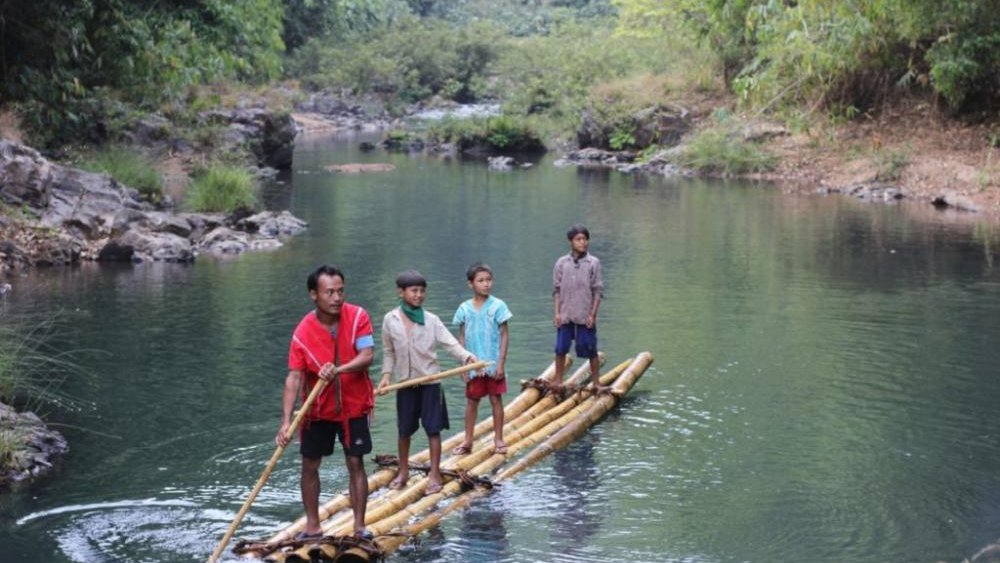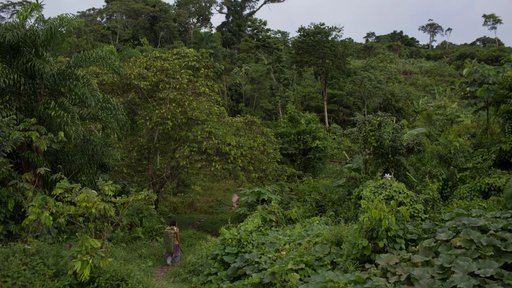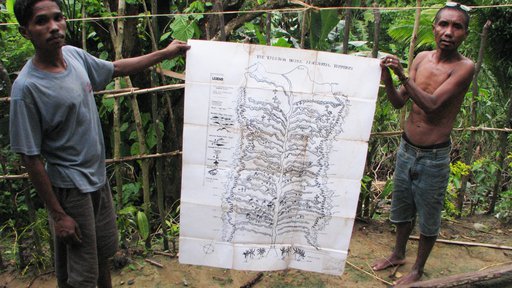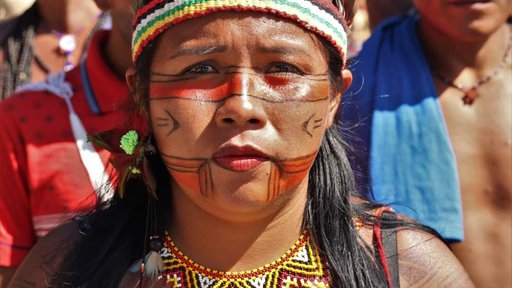Indigenous communities & biodiversity
Securing land rights of communities and giving land back

“We should be the leaders of conservation, not victims of it.”
Archana Soreng from the Khadia Tribe, India - member of the UN Youth Advisory Group on Climate Change
There is a widespread belief in western industrial societies that landscapes with high biodiversity, such as the Amazon rainforest, are "wilderness," i.e., places completely unaffected by humans, left to their own devices. This is a notion that has its roots in colonial times. "Wilderness" and "civilization" just like "nature" and "culture" were portrayed as opposites in colonialism, and this tradition continues in Western thought to this day.
For some time now, however, there has been a growing recognition in the scientific community that such supposedly "wildernesses" are in fact ancient cultural landscapes that have been influenced by the Indigenous population for thousands of years. This influence of humans on nature has contributed to the great diversity that can be seen in the Indigenous territories today.
Humans have always influenced ecosystems since the Stone Age and their spread around the world, both in positive and negative ways. Ancient cultures on different continents have also wiped out entire species. Other cultures, on the other hand, have developed systems of knowledge through experience and trial and found a way to live well from and with nature for thousands of years and to secure the basis of life for future generations.
Guardians of nature - without calling it "nature conservation"
In the Amazon, for example, indigenous groups see themselves as guardians of the forest and fight to preserve their traditional ways of life. After a long period of disregard, Western science now confirms that the presence of indigenous people over millennia has been essential to the creation of the landscape. Through practical experiential knowledge and the strong, also spiritually based integration into their environment, they have come to a way of life that is characterized by a reciprocal relationship with the landscape. This mutual coexistence, which in these cases is equally beneficial for humans and nature, does not draw a sharp line between the two.
So Indigenous communities in the Amazon have increased biodiversity through their management of the forests. Archaeological research shows that before the arrival of the European colonizers, complex and highly diverse societies lived in the Amazon region, cultivating the forest surrounding their settlements and planted trees that were useful for their way of life. As the composition of the tree cover changed, entire ecosystems also changed. The soils in the some parts of the Amazon region were also shaped by humans - the method of the so-called Terra Preta, a special soil cultivated over generations in the surroundings of human settlements over an astonishingly large area, is considered evidence of the human shaping of the Amazon region. Humans and nature adapted to each other over thousands of years. Colonization, together with epidemics caused by introduced germs, interrupted this sophisticated management and led to the collapse of many Indigenous societies.

The shaping of the landscape by Indigenous societies has also numerous examples on other continents, such as the traditional fire tending among the Indigenous Peoples of Australia, or the pastoralism of the Plains cultures of North America (Lakota, Sioux and others) and the reindeer herding cultures of the Arctic. Some of these ways of life were destroyed in the course of colonization, others still exist today and are very successful. There are world views, such as those of the Maori of "stewardship" and "kinship", i.e. seeing the rest of nature as relatives, but also to take care and responsibility for them.
“[Indigenous Peoples] are well known to be the first impacted by the loss of biodiversity, by the desertification or climate change and they're nevertheless the guardians of biodiversity.”
Hindou Oumarou Ibrahim - a Mboro from Chad, environmental activist and geographer
Indigenous Communities protect 80% of the world's biodiversity
According to UN reports, 80% of the world's animal and plant species are found on Indigenous territories, which account for a quarter of the land area worldwide. People who have been using their land in traditional ways for generations live with nature without calling it "nature conservation" - but the result is a way of life that truly deserves to be called "sustainable." In fact, there are also conservation areas that are decided and implemented by Indigenous Peoples and Local Residents, which are often called ICCAs (Indigenous Community Conservation Area) and are networked in a global consortium. However, Indigenous communities are now in contact with and influenced by the western world. For example, when reindeer herders or hunters in the Arctic now use snowmobiles, modern rifles or radios as a matter of course.
The importance of Traditional Environmental Knowledge (TEK), and Indigenous communities for nature conservation is increasingly being discussed and discussed and also included. It must be ensured that, above all, the power relations change, this concerns in particular also the funding, access to media, etc. It is not enough to just formally recognize local people, instead, respectful, equal relationships need to be built with western NGOs where the local organizations are always the ones making decisions for their country.
Recent research shows that Indigenous Peoples and local communities around the world manage forests with carbon levels that are 33 times our current annual emissions – although even this staggering figure is likely an underestimate. At the same time, research clearly shows that areas managed by Indigenous peoples have lower deforestation rates and achieve better conservation outcomes than protected areas that exclude Indigenous Peoples.
Human rights for the defenders of nature - the basis for successful nature conservation
The dark side of these facts is that Indigenous communities also suffer a highly disproportionate number of attacks on land defenders. Traditional land ownership without land titles is often not recognized by nation states. Profit-driven business practices and government policies that prioritize resource extraction and industry at the expense of human rights put these people and their land at risk.
Indigenous communities around the world are fighting for justice and the return of land (e.g., the Land Back Movement in the U.S.) that was taken from them under colonialism, and against further land grabs in the name of capitalist economy. In addition to fighting against mines, coal-fired power plants, large dams, and industrial agriculture, this includes preventing new natural parks that operate on the model of fortress conservation (which means the de facto loss of land for the local population).
Indigenous environmentalists and land rights activists are frequently subjected to violence and are also being murdered, as evidenced by many reports, such as the Global Witness statistics, for example. In 2019, for example, approx. 212 people were murdered because they wanted to protect the environment and their land, there are similar numbers every year. Half of these murders happen in Colombia and the Philippines, but Brazil and Central America are also very dangerous for land defenders. Indigenous people are particularly affected, accounting for 40% of the killed, which is a lot in relation to their of the total population. Therefore, there are agreements that are supposed to protect the environmental defenders, such as the Aarhus Convention for Europe or the Treaty of Escazú for Latin America. This treaty guarantees Freedom of Information about environmental projects, public participation in decision-making processes and access to justice and legal proceedings in environmental matters. The treaty was signed by Argentina as recently as January 22nd 2021 and has reached enough signatures from Latin American countries to enter into force 3 months later - a big win for human rights and a success for social mobilization.
“We will be able to protect biodiversity only when we feel secure – for which it is important to respect, recognize and enforce our right over our lands and our forests.”
Archana Soreng from the Khadia Tribe, India, member of the UN Youth Advisory Group on Climate Change
Securing land rights, giving land back to communities

However, there are also many examples where indigenous communities, by securing their land rights, can combine the proven traditional use of the areas with self-determined nature conservation and continue to preserve the biodiversity there. Conservation must always be thought of together with human rights and the right to self-determination in order to be successful in the long term. At the same time, western societies should realize that in their countries biodiversity has already been heavily destroyed by industry, especially agriculture. In Germany about 1/3 of the mammal species are endangered and the German nature reserves are insufficiently protected according to the EU. Here it would be enormously important to engage locally to preserve nature-culture-landscapes and to renaturalize degraded places, e.g. to rewet moors so that they also store carbon. More fundamentally, Western cultures would have to critically question their worldview, acknowledge their own dependence on nature, and change their own societies and industries to stop the 6th mass extinction of species.
Sources
We would like to share the materials collected on this page in a spirit of support and solidarity.
As a small group, we unfortunately do not have the capacity to research all the contacts and contact the authors, creators and contributors of the materials listed on this page and to ask them explicitly for their permission, to be linked in this context.
If you are the author, creator, or contributor of any of these materials of any of these materials and do not consent to their use in this context, please let us know at presse(at)extinctionrebellion.de and we will remove it.
VIDEOS/AUDIO
ICCAs and the ICCA Consortium - Conserving territories of life
Indigenous peoples and local communities around the world protect and care for their collective territories, lands and waters as a matter of survival, health and wellbeing. These territories and areas are cradles of biological and cultural diversity and crucial for all life on Earth. A film by LifeMosaic and the ICCA Consortium
ATREE CEPF: Indigenous Communities and Conservation
Several conservations projects through/with Indigenous communities in western India, with varying degrees of self-determination of the communities
Mongabay Podcast, Mike Gaworecki: Indigenous land rights and the global push for land privatization
On the importance of securing Indigenous communities’ land rights and the global push for privatization that can deprive those communities of access to their land
ARTICLES
Al Jazeera, Jenni Laiti, Florian Carl: A victory over Sweden’s colonialism
A new EJAtlas map launched by the Institut de Ciència i Tecnologia Ambientals ICTA-UAB denounces that the current model puts growth and gains before human lives and the nature it is intended to protect.
Universitat Autònoma de Barcelona: Indigenous knowledge, key to a successful ecosystem restoration
Ecological restoration projects actively involving indigenous peoples and local communities are more successful. This is the result of a study carried out by the ICTA-UAB, which places value on indigenous and local knowledge contribution in the restoring of degraded ecosystems.
UN Environment Programme, Siham Drissi: Indigenous peoples and the nature they protect
environment-rights.org: The Escazu Agreement
This landmark treaty aims to guarantee the full and effective implementation in Latin America and the Caribbean of the rights of access to environmental information, public participation in the environmental decision-making and access to justice in environmental matters.
Mongabay, Liz Kimbrough: Human rights-based conservation is key to protecting biodiversity: Study
Mongabay, Carolyn Cowan: Award-winning Thai community continues the fight to save its wetland forest
briarpatch magazine, Jade Delisle: Decolonizing ecology
Examples of Indigenous restoration projects in Canada
"At a time when Indigenous land defenders are fighting for cultural resurgence and the application of traditional knowledge to combat the climate crisis, they are often cast as the monolithic, mystical, degrowth opposition to the secular modernity of white leftists and their fully automated socialist future. In reality, solutions to ecological and social problems that were historically or are presently used by non-European cultures are compatible with modern technology, often in consensus with cutting-edge scientific findings, and more necessary than ever."
About the Locally-Managed Marine Are Network
Locally-Managed Marine Areas: Those differ from what is commonly known as a Marine Protected Area (MPA) in that LMMAs are characterized by local ownership, use and/or control, and in some areas follows the traditional tenure and management practices of the region, whereas MPAs in the formal sense are typically designated via a top-down approach with little if any local input.
Mail & Guardian, Terry Teegee: A healthy Earth needs its indigenous people
A Canadian Indigeneous perspective
In-depth reading:
Methods of Prevention, Mitigation and Adaptation of Indigenous stewards towards invasive species.
Article from an Indigenous perspective with emphasis on goals and motivations - instead of vulnerability narratives which are a common misrepresentation of Indigenous peoples in discourse.
